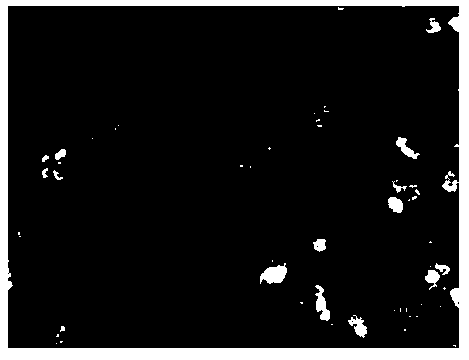Hydrothermal synthesis method for positive pole material lithium manganese phosphate nanoparticles of lithium-ion batteries
A hydrothermal synthesis method, a technology for lithium ion batteries, applied in battery electrodes, phosphorus compounds, nanotechnology, etc., can solve the problems of slow lithium ion diffusion, unseen, poor conductivity, etc., to improve high current charge and discharge performance , Easy to scale production, low cost effect
- Summary
- Abstract
- Description
- Claims
- Application Information
AI Technical Summary
Problems solved by technology
Method used
Image
Examples
example 1
[0022] 1) Dissolve 2.00 g of P123 in 20 ml of deionized water, stir for 240 minutes, then add 3.38 g of manganese sulfate and 0.20 g of ascorbic acid, stir until fully dissolved, and obtain a manganese source concentration of 1.0 mol / L and an ascorbic acid concentration of 0.076 mol / L L, a solution A with a templating agent concentration of 0.1 g / mL;
[0023] 2) Dissolve 1.96g of phosphoric acid and 2.56g of lithium sulfate in 20 ml of deionized water and stir for 30 minutes to form a suspension B with a phosphoric acid concentration of 1.0 mol / L and a lithium source concentration of 1.0 mol / L;
[0024] 3) Add the suspension B prepared in step 2) dropwise to the solution A prepared in step 1) under stirring to form emulsion C. The molar ratio of Li, Mn, and P in emulsion C is 1:1:1.
[0025] 4) Transfer the emulsion C in step 3) to a 60ml autoclave, add 0.112 g of KOH, stir well, and then adjust its volume to 40ml with deionized water, so that the concentration of KOH is 0.05...
example 2
[0028] 1) Dissolve 4.00 g of P123 in 20 ml of deionized water, stir for 240 minutes, then add 6.76 g of manganese sulfate and 0.40 g of ascorbic acid, stir until fully dissolved, and obtain a manganese source concentration of 2.0 mol / L and an ascorbic acid concentration of 0.152 mol / L L, the solution A whose template concentration is 0.2 g / mL;
[0029] 2) Dissolve 3.92g of phosphoric acid and 3.36g of lithium hydroxide in 20 ml of deionized water and stir for 30 minutes to form a suspension B with a phosphoric acid concentration of 2.0 mol / L and a lithium source concentration of 4.0 mol / L;
[0030] 3) Add the suspension B prepared in step 2) dropwise to the solution A prepared in step 1) under stirring to form emulsion C. The molar ratio of Li, Mn, and P in emulsion C is 2:1:1.
[0031] 4) Transfer the emulsion C in step 3) to a 50ml autoclave, add 0.224g of KOH, stir well, then adjust its volume to 40ml with deionized water, so that the concentration of KOH is 0.10 mol / L, an...
example 3
[0034] 1) Dissolve 3.00 g of F127 in 20 ml of deionized water, stir for 240 minutes, then add 5.94 g of manganese chloride and 0.32 g of ascorbic acid, stir until fully dissolved, and obtain a manganese source concentration of 1.5 mol / L and an ascorbic acid concentration of 0.091 mol / L, the template concentration is solution A of 0.15 g / mL;
[0035] 2) Dissolve 2.94g of phosphoric acid and 3.78g of lithium hydroxide in 20 ml of deionized water and stir for 30 minutes to form a suspension B with a phosphoric acid concentration of 1.5 mol / L and a lithium source concentration of 4.5 mol / L;
[0036] 3) Add the suspension B prepared in step 2) dropwise to the solution A prepared in step 1) under stirring to form emulsion C. The molar ratio of Li, Mn, and P in emulsion C is 3:1:1.
[0037] 4) Transfer the emulsion C in step 3) to a 60ml autoclave, add 0.336g of KOH, stir well, then adjust its volume to 40ml with deionized water, so that the concentration of KOH is 0.15 mol / L, and ...
PUM
 Login to View More
Login to View More Abstract
Description
Claims
Application Information
 Login to View More
Login to View More - R&D
- Intellectual Property
- Life Sciences
- Materials
- Tech Scout
- Unparalleled Data Quality
- Higher Quality Content
- 60% Fewer Hallucinations
Browse by: Latest US Patents, China's latest patents, Technical Efficacy Thesaurus, Application Domain, Technology Topic, Popular Technical Reports.
© 2025 PatSnap. All rights reserved.Legal|Privacy policy|Modern Slavery Act Transparency Statement|Sitemap|About US| Contact US: help@patsnap.com

